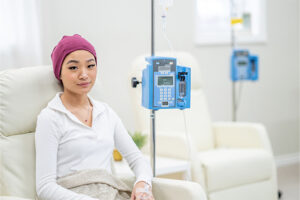Oncology
HER2+ Breast Cancer
Identifying Candidates for Neoadjuvant or Adjuvant Anti-HER2 Therapy
Overview
Individualizing therapy for patients with human epidermal growth factor receptor 2–positive (HER2+) breast cancer currently involves the consideration of such factors as tumor size, nodal status, and response to neoadjuvant therapy. Ongoing trials are exploring newer strategies for neoadjuvant and adjuvant therapies to further optimize the paradigm.
Expert Commentary
Sara M. Tolaney, MD, MPH
|
|
“For a patient who is newly diagnosed with HER2+ breast cancer and has a tumor that is larger than 2 cm in size, or if they have lymph node involvement, I generally recommend preoperative therapy followed by surgery, and then we would see what is found at the time of surgery and tailor adjuvant therapy based on this.”
For a patient who is newly diagnosed with HER2+ breast cancer and has a tumor that is larger than 2 cm in size, or if they have lymph node involvement, I generally recommend preoperative therapy followed by surgery, and then we would see what is found at the time of surgery and tailor adjuvant therapy based on this. It is really important that we administer treatment prior to the surgery in this case so that we can understand how the tumor responds to it, which helps us to choose the best adjuvant treatment for them, since the response to neoadjuvant therapy shows how sensitive their cancer is to treatment.
For patients with stage II or III disease, we give neoadjuvant docetaxel, carboplatin, trastuzumab, and pertuzumab (known as the TCHP regimen) for 6 cycles. If the patient has a pathologic complete response to therapy, I usually give them adjuvant trastuzumab and pertuzumab to complete a total of 1 year of HER2-directed therapy. If, on the other hand, we find residual disease at the time of surgery (ie, the TCHP did not eradicate the cancer), we would proceed with a different approach. Based on data from the phase 3 KATHERINE trial, we would switch their therapy to trastuzumab emtansine (T-DM1) for 14 cycles.
Patients with tumors that are smaller than 2 cm and with no lymph node involvement were excluded from the initial pivotal trials of adjuvant trastuzumab because it was felt that they were at lower risk. And, while these individuals do have a favorable prognosis, retrospective data suggest that, if they do not receive systemic therapy, their risk of recurrence might be as high as 20% to 30%. Data to guide treatment for patients with stage I HER2+ disease come from the APT trial, which showed that 12 weeks of adjuvant paclitaxel plus trastuzumab (TH) was associated with excellent 10-year outcomes and very few distant recurrences. Further, the phase 2 ATEMPT trial looked at 1 year of adjuvant T-DM1 therapy and showed excellent 5-year outcomes that are consistent with APT. So, I think that either TH or T-DM1 is an appropriate treatment option for patients with stage I HER2+ breast cancer.
Those are the general paradigms that we think about, and there are a lot of ongoing trials in this setting. Such studies include those for patients with residual disease, such as the CompassHER2 RD and the DESTINY-Breast05 trials. There is also the ongoing DESTINY-Breast11 trial, which is comparing neoadjuvant trastuzumab deruxtecan (T-DXd) monotherapy or T-DXd followed by paclitaxel, trastuzumab, and pertuzumab (THP) with TCHP. There are also trials looking to tailor the preoperative regimen, including CompassHER2-pCR, which is giving preoperative THP followed by adjuvant trastuzumab and pertuzumab for patients who achieve a pathologic complete response. Looking to the future, I think that these trials will lead to changes in the neoadjuvant and adjuvant treatment of HER2+ breast cancer, and I am hopeful that we will continue to develop and refine predictive biomarkers that will enhance our ability to tailor treatments to individual patients.
References
ClinicalTrials.gov. CompassHER2-pCR: decreasing chemotherapy for breast cancer patients after pre-surgery chemo and targeted therapy. Updated June 22, 2023. Accessed September 5, 2023. https://classic.clinicaltrials.gov/ct2/show/NCT04266249
Dowling GP, Keelan S, Toomey S, Daly GR, Hennessy BT, Hill ADK. Review of the status of neoadjuvant therapy in HER2-positive breast cancer. Front Oncol. 2023;13:1066007. doi:10.3389/fonc.2023.1066007
Geyer CE Jr, Untch M, Prat A, et al. Abstract OT-03-01: trastuzumab deruxtecan (T-DXd; DS-8201) vs trastuzumab emtansine (T-DM1) in high-risk patients with HER2-positive, residual invasive early breast cancer after neoadjuvant therapy: a randomized, phase 3 trial (DESTINY-Breast05) [abstract OT-03-01]. Abstract presented at: 2020 San Antonio Breast Cancer Symposium; December 8-11, 2020.
Harbeck N, Boileau J-F, Modi S, et al. Abstract OT1-12-04: a phase 3, open-label trial of neoadjuvant trastuzumab deruxtecan (T-DXd) monotherapy or T-DXd followed by THP compared with ddAC-THP in patients with high-risk HER2-positive early-stage breast cancer (DESTINY-Breast11) [abstract OT1-12-04]. Abstract presented at: 2021 San Antonio Breast Cancer Symposium; December 7-10, 2021; San Antonio, TX.
He X, Ji J, Tian M, Esteva FJ, Hortobagyi GN, Jim Yeung S-J. Long-term survival analysis of adjuvant chemotherapy with or without trastuzumab in patients with T1, node-negative HER2-positive breast cancer. Clin Cancer Res. 2019;25(24):7388-7395. doi:10.1158/1078-0432.CCR-19-0463
O'Shaughnessy J, Gradishar W, O'Regan R, Gadi V. Risk of recurrence in patients with HER2+ early-stage breast cancer: literature analysis of patient and disease characteristics. Clin Breast Cancer. 2023;23(4):350-362. doi:10.1016/j.clbc.2023.03.007
O’Sullivan CC, Ballman KV, McCall L, et al. Alliance A011801 (compassHER2 RD): postneoadjuvant T-DM1 + tucatinib/placebo in patients with residual HER2-positive invasive breast cancer. Future Oncol. 2021;17(34):4665-4676. doi:10.2217/fon-2021-0753
Tarantino P, Tayob N, Dang CT, et al. Abstract PD18-01: adjuvant trastuzumab emtansine versus paclitaxel plus trastuzumab for stage I HER2+ breast cancer: 5-year results and correlative analyses from ATEMPT (TBCRC033) [abstract PD18-01]. Abstract presented at: 2022 San Antonio Breast Cancer Symposium; December 6-10, 2022; San Antonio, TX.
Tolaney SM, Tarantino P, Graham N, et al. Adjuvant paclitaxel and trastuzumab for node-negative, HER2-positive breast cancer: final 10-year analysis of the open-label, single-arm, phase 2 APT trial. Lancet Oncol. 2023;24(3):273-285. doi:10.1016/S1470-2045(23)00051-7
Tolaney SM, Tayob N, Dang C, et al. Adjuvant trastuzumab emtansine versus paclitaxel in combination with trastuzumab for stage I HER2-positive breast cancer (ATEMPT): a randomized clinical trial. J Clin Oncol. 2021;39(21):2375-2385. doi:10.1200/JCO.20.03398
von Minckwitz G, Huang C-S, Mano MS, et al; KATHERINE Investigators. Trastuzumab emtansine for residual invasive HER2-positive breast cancer. N Engl J Med. 2019;380(7):617-628. doi:10.1056/NEJMoa1814017
von Minckwitz G, Procter M, de Azambuja E, et al; APHINITY Steering Committee and Investigators. Adjuvant pertuzumab and trastuzumab in early HER2-positive breast cancer [published corrections appear in N Engl J Med. 2017;377(7):702 and N Engl J Med. 2018;379(16):1585]. N Engl J Med. 2017;377(2):122-131. doi:10.1056/NEJMoa1703643











